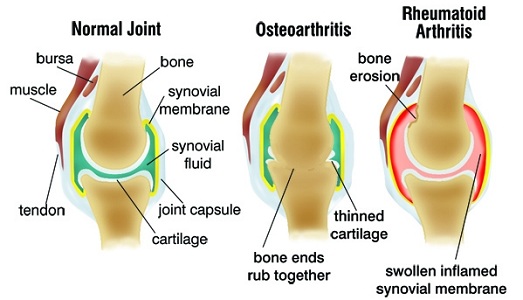Have you or a loved one been diagnosed with osteoarthritis or rheumatoid arthritis, and you are wondering what this means? Osteoarthritis (OA) and rheumatoid arthritis (RA) are the two most prevalent types of the joint damaging condition. Osteoarthritis, the more common, is a result of wear and tear of the cartilage covering the ends of joint bones. Rheumatoid arthritis results from an immune system's defective attack of the lining within joints. This leads to swelling and pain and can ultimately lead to deformity of the joints.

Osteoarthritis vs. Rheumatoid Arthritis
1. Differences in Affected Areas
Bones within a joint are covered in cartilage which prevents the bones from touching each other. Osteoarthritis occurs when this cartilage breaks down and joint bones touch, causing excruciating pain. Osteoarthritis is also known as wear and tear arthritis. It starts within one joint.
Rheumatoid arthritis is an autoimmune condition of chronic inflammation within joints. It occurs when the autoimmune system attacks joint lining tissue known as synovium. It affects many joints, and can also affect other body tissues and organs.
2. Differences in Causes
Osteoarthritis occurs when the cartilage covering joint bones breaks down. While common belief has been that osteoarthritis results from wear and tear associated with advancing age, recent studies point to other reasons of its occurrence. Affected cartilage has been shown to have decreased protein and increased water content. Other risk factors of osteoarthritis include:
- Genetic makeup
- Injury
- Obesity or excess weight
- Joint stress due to repetitive use
Although researchers have conducted many studies, the cause of rheumatoid arthritis remains unknown. It is, however, known that the condition has a genetic predisposition.
3. Differences in Symptoms
There are similarities and differences in symptoms of osteoarthritis vs. rheumatoid arthritis.
Osteoarthritis symptoms include:
- Painful joints especially after repeated use
- Stiff joints in the morning lasting for up to 30 minutes
- Swelling and heat in the joints following inactivity
- Enlarged joint bones leading to limited movement
Symptoms of rheumatoid arthritis include:
- Painful and stiff joints
- Swelling of the joints
- Limited motion capability
- Heat/redness around the joints
- Morning joint stiffness lasting for an hour or more
- Excess fatigue
- Rheumatoid nodes
- Symmetrical joints involved (e.g. both knees)
- Small hand and feet bones involved
- Cardiac, kidney and lungs may also be involved
4. Differences in Diagnosis
There are similarities in diagnosing the two conditions. An X-ray of an affected joint shows the damage of either condition. Other diagnosing procedures include removal of joint fluid or arthrocentesis, and joint fluid analysis. Results of these tests help to differentiate between osteoarthritis vs. rheumatoid arthritis.
While a blood test cannot help to diagnose osteoarthritis, it can help rule out rheumatoid arthritis. A combination of physical examination, tests and medical history can help in diagnosing rheumatoid arthritis. Laboratory tests to diagnose rheumatoid arthritis include:
- Rheumatoid factor test
- C reactive protein test
- Erythrocyte sedimentation test
- Anti-CCP test
5. Differences in Treatments
Osteoarthritis vs. rheumatoid arthritis treatments have both similarities and differences.
Treatment of osteoarthritis focuses on relieving pain, reducing inflammation and restoration of joint function. Common medications for pain and inflammation in osteoarthritis treatment include:
- Non-steroidal anti-inflammatory drugs(NSAIDs)
- Steroidal injections
- Analgesics
Other osteoarthritis treatment options include physical therapy to stabilize and strengthen affected joints, heat treatment, support/bracing, rest, and reduction of body weight. In addition, alternative treatment methods such as acupuncture and massage are used.
Rheumatoid arthritis is treated using five main types of medication:
- Painkillers or analgesics
- Non-steroidal anti-inflammatory drugs (NSAIDs)
- Disease-modifying anti-rheumatic drugs (DMARDs)
- Biologics, including Remicade, Enbrel, Humira, Orencia and Rituxan
- Corticosteroids, including hydrocortisone and prednisone
Besides medication, alternative and/or complementary methods are used in rheumatoid arthritis management. Osteoarthritis and rheumatoid arthritis patients may also opt for surgery or arthroscopy. The two types of surgery used to treat the two types of arthritis are:
- Joint replacement or arthroplasty
- Fusion or arthrodesis
6. Differences in Prevalence, Age and Gender
Osteoarthritis vs. rheumatoid arthritis, which one is more prevalent?
Studies show that in the U.S. alone, 27 million people suffer from osteoarthritis. The condition occurs more in people above the age of 65. Studies by the American College of Rheumatology show that about 70 percent of the population above 70 years of age has X-ray confirmation of osteoarthritis.
Rheumatoid arthritis affects about 1.5 million people in the U.S. and up to 2 percent of the global population. It affects more women than men, with females accounting for 75 percent of rheumatoid arthritis patients. It affects people of all ages. However, it is more common in those aged between 30-60. In men, rheumatoid arthritis is more common in later life.
